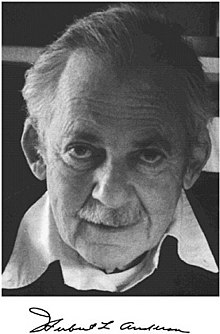Herbert L. Anderson
Herbert Lawrence Anderson (born May 24, 1914 in New York City , † July 16, 1988 in Los Alamos ) was an American nuclear physicist.
Anderson studied at Columbia University (bachelor's degree in 1931, in electrical engineering in 1935), where he received his doctorate in 1940 with John Ray Dunning (1907-1975). During this time he was instrumental in building a cyclotron under the direction of Dunnington. He also built other laboratory equipment such as ionization chambers and amplifiers. In January 1939 he was a member of the first team in the USA that repeated at Columbia University the experiments of Otto Hahn and Fritz Straßmann on nuclear fission, which had recently become known through lectures by Niels Bohr at Princeton . Under Fermi he experimented further to study nuclear fission and was also one of its most important assistants (with Walter Henry Zinn ) in the construction of the first nuclear reactor in Chicago in 1942. Anderson then directed the construction of the CP-2 reactor at the Argonne National Laboratory and was a consultant for DuPont building the breeder reactors in Hanford .
After the war he went with Fermi to the University of Chicago , where he was Assistant Professor from 1946, Associate Professor from 1947 and Professor from 1950 (Distinguished Service Professor from 1977). 1958 to 1962 he was director of the Enrico Fermi Institute there. After working repeatedly at the Los Alamos National Laboratory , he joined the laboratory in 1978 and stayed there until his death, most recently as a Senior Fellow.
He died from the effects of beryllium -Verseuchung of the lungs ( beryllium disease ), which he drew upon forty years previously in experiments in Fermi's laboratory.
In 1932 he became a Fellow of the American Physical Society . From 1955 to 1957 he was a Guggenheim Fellow and 1956/57 as a Fulbright Lecturer in Italy. In 1982 he received the Enrico Fermi Prize . He was a member of the National Academy of Sciences (1960) and the American Academy of Arts and Sciences (1978).
Individual evidence
- ↑ The dissertation “Resonance Capture of Neutrons by Uranium” was published ten years later for reasons of secrecy, Physical Review, Vol. 80, 1950, pp. 499–506
- ^ Other members were Enrico Fermi , Dunning, Eugene T. Booth, G. Norris Glasoe, Francis G. Slack, published as "The Fission of Uranium", Physical Review, Vol. 55, 1939, pp. 511-512. At around the same time, nuclear fission attempts were repeated by numerous teams of physicists in the USA.
- ↑ CP for Chicago Pile, it was Fermi's first reactor CP-1 in the center of Chicago, which was dismantled there after the tests and rebuilt at a safe distance.
- ↑ Laura Fermi reports on this in her memoirs "Mein Mann und das Atom", Eugen Diederichs, 1956, p. 202. They dried beryllium / radium powder, which was supposed to serve as a neutron source, on a stove, the sample started to burn
| personal data | |
|---|---|
| SURNAME | Anderson, Herbert L. |
| ALTERNATIVE NAMES | Anderson, Herbert Lawrence (full name) |
| BRIEF DESCRIPTION | American nuclear physicist |
| DATE OF BIRTH | May 24, 1914 |
| PLACE OF BIRTH | New York City |
| DATE OF DEATH | July 16, 1988 |
| Place of death | Los Alamos |
